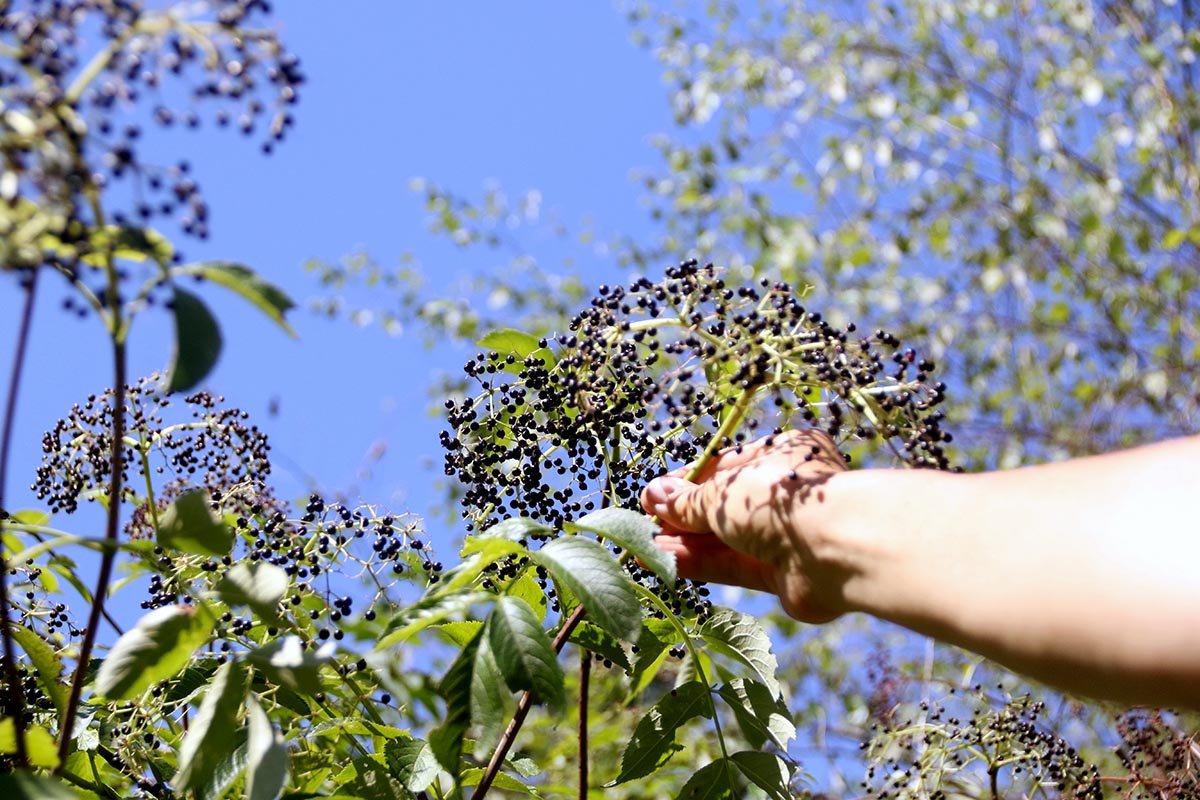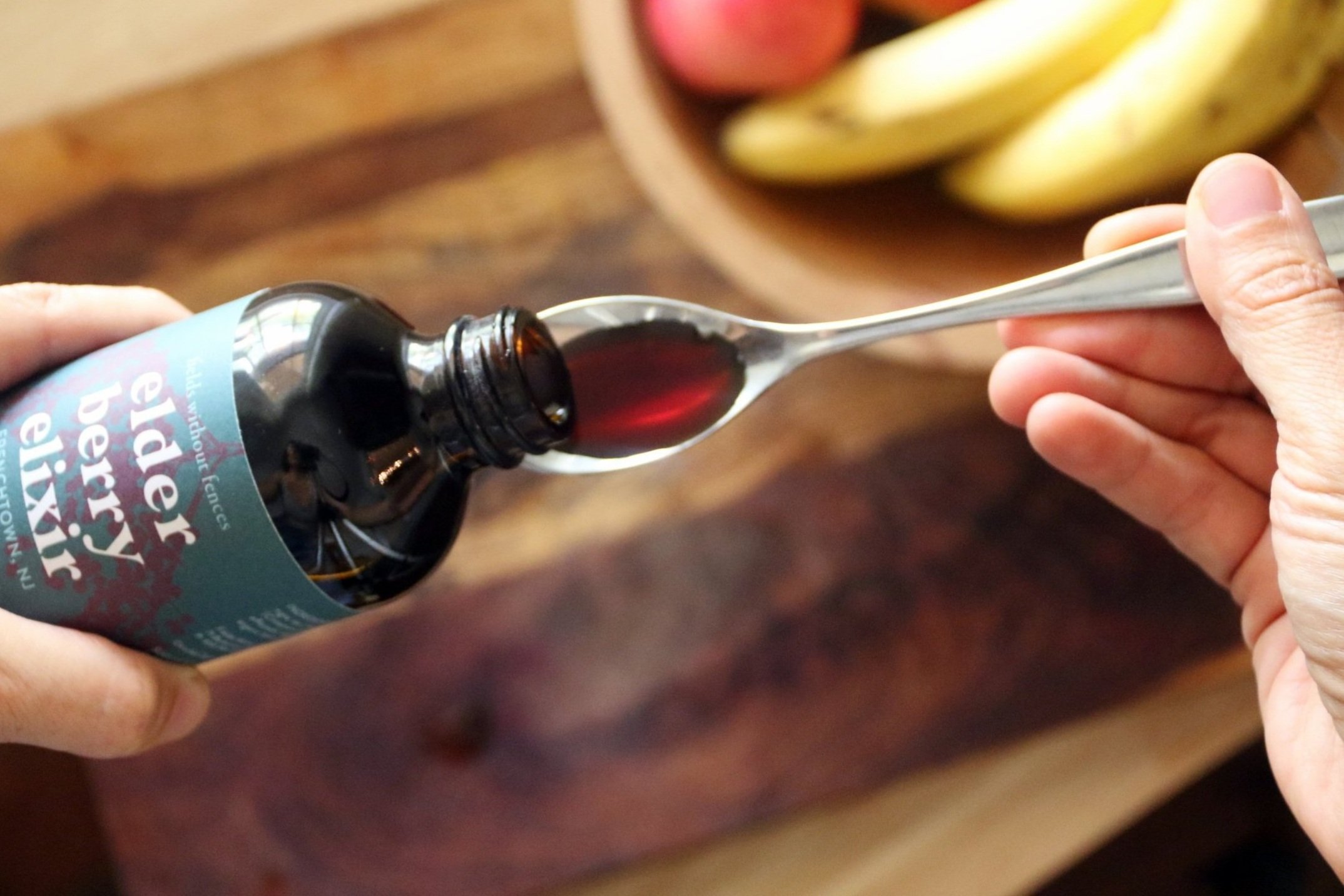How To Use Elderberries?
/Understanding the art & science of the tiny berry of mythological proportion
by Lindsay Napolitano
Elderberry fruiting, fields without fences, 2022
Perhaps you know about the impressive immunological effects of elderberry. You've heard plenty of anecdotes from friends and family about preventing colds and swiftly recuperating from the flu. Maybe you’re well versed in the powerful anti-inflammatory potential of dark berries, and once read that the elderberry boasts one of the highest antioxidant content of all berries… But still one lingering question remains, perhaps the most essential question of all… how exactly am I supposed to take it?
As with most things, in order to understand the how, we’ll first need to set some context with the whom.
Who is elderberry good for?
It was alleged that in the time of Charlemagne, a mandate ordering all dwellings to include an elder on their premises for purposes of health, was ordained directly from the high seat of the Holy Roman Emperor himself. When it comes to elderberry, it’s easy to paint in broad strokes. Its antioxidant, anti-inflammatory, and cardiovascular benefits are near universal. The berry portion of the plant has a wide therapeutic range, while its associated risks are near invisible when prepared correctly (more on that later). And so with the same assumed assuredness of a ninth century ruler, one could answer the question; who is elderberry good for, with a resounding, “why, everyone.”
Cultures throughout the northern temperate climate have feasted on the medicinal fruits of the elderberry in drinks, jams, jellies, syrups, elixirs, and all manner of baked goods for thousands of years. In the cold climates of northern Europe where grapes could not survive, ancient inhabitants drank a deeply pigmented wine made of elderberry. In the consolidated tome of Native American Ethnobotany, it’s noted that Kitasoo, Kwakiutl, and Makah peoples made dried cakes of elderberry, and dined on them throughout the winter months (1998). Elderberry, in addition to being highly medicinal, has been absorbed into the culinary traditions of peoples across the planet.
As such, elderberry could best be characterized as a “food herb,” or a “superfood” to use the jargon of our time. A food with exceptional health benefits due to its elevated concentrations of vitamins, minerals, antioxidants, and other beneficial compounds. A food with phytochemicals that support our immunity and improve cardiovascular health. A food that could very well play a role in reducing the rate of chronic degenerative conditions. A food for all!
What is elderberry good for?
VIRAL EXPOSURE
Elder lore is filled with stories of protection playing out on thresholds between worlds. As it comes, the essential content of culture is carried within evolving mythologies that take the tenor of the times.
In 2009, scientists impressed by the growing body of evidence demonstrating elderberry to be antiviral, designed an experiment utilizing an ionization technique in mass spectrometry to better understand the mechanism by which elderberry protected against viral infection. What they observed through the direct binding assay, was an extract of elderberry binding to the H1N1 flu virus and consequently, blocking passage into the cell wall to infect the host (Roschek et al., 2009).
The quantitative instrumentation of science was able to give new language to working knowledge that had been observed throughout time. Elderberry, a mediator between realms, provides remarkable protection from infection. A meta analysis in 2019 confirmed the protective quality of elderberry in a study that found supplementation with elderberry reduced upper respiratory symptoms with a mean size effect large enough for the paper’s authors to suggest elderberry is “a potentially safer alternative to prescription drugs for routine cases of the common cold and influenza” (Hawkins et al., 2019).
LOWERING INFLAMMATION
Seven hundred years before Charlemagne sat on the throne, Roman physicians used the verb “inflammare” to describe the red, hot, fire-like qualities of swollen tissues that surround wounds and rheumatic pain. The inflammatory process is initiated every time the body receives an injury or perceives a potential threat in the form of pollen, foreign microbes, synthetic chemicals, and the like that enter our bodies by way of our environment. It's a helpful immunological process that serves to stave off infection and initiate healing, but appears to have an unfavorable tipping point. Chronic inflammation has been linked with a suite of chronic degenerative conditions that plague our populace at present including cancer, heart disease, diabetes, arthritis, depression, and Alzheimer’s.
Recent studies have demonstrated that flavonoids, like those contained in elderberry, “can inhibit regulatory enzymes or transcription factors important for controlling mediators involved in inflammation,” meaning chronic inflammation is discouraged systemically (Maleki, Crespo, & Cabanillas, 2019). Compared with other fruit, elderberry boasts an exceptionally high concentration of anthocyanins, a type of flavonoid that protects tissues from damage against free radicals, and thereby stops inflammatory responses from being initiated to begin with.
CARDIOVASCULAR HEALTH
The Doctrine of Signatures - a symbolic language that arose throughout various cultures (by different names and different ontologies) to catalog and elucidate patterns in the physical presentation of plants - frequently ascribes the color deep red or purple, like that of the richly hued elderberry, as having association with blood. Hollow interiors, like the empty corridor that forms when the interior pith of an elder branch has decomposed, are connected to portals of both the anatomical and magical variety within this language.
The vasculature, a hollow network of corridors throughout the body, contains the course of blood as it moves throughout the entirety of our physical being. When the integrity of our vascular system is healthy, our blood flows freely and unobstructed. Atherosclerosis, the buildup of plaques within the artery walls, is a process that can hinder cardiovascular function and lead to heart attack. In a year 2000 study, elderberry was found to ameliorate markers of endothelial dysfunction, an early indicator of atherosclerosis, prompting the study’s authors to suggest elderberry “could be used as a potential nutritional aid for preventing atherosclerosis progression” (Youdim, Martin, & Joseph, 2000).
NOVEL EXPLORATIONS
Preliminary studies suggest that elderberry extracts may exhibit anticancer properties. A study by Strugała et al. (2018) reported that an elderberry extract showed inhibitory effects on the growth of breast cancer cells in vitro. While further research is warranted, these findings open the door for potential cancer-fighting applications. Additionally, elderberry has shown promise in managing diabetes. A study by Thanh Thi Ho et al. (2017) revealed that elderberry extracts improved insulin sensitivity in cell studies. More research is needed to understand the full extent of elderberry’s impact on diabetes management in humans. Elderberry has strong prebiotic potential, and may have a positive role to play in the function of the gut-brain-axis. An animal study by Namakin et al. (2023), indicated elderberry “could be a promising research target” to ameliorate classic Irritable Bowel Syndrome symptoms.
With benefits so robust and numerous, we are only beginning to formally quantify the health producing effects of elderberry. Generally safe for most kids and adults, elderberry is part modern medicinal wunderkind, part ancient traditional food.
How often should I take it?
Elderberry Harvest, fields without fences, 2022
Medicines from the earth, in comparison to synthetic counterparts, are easily metabolized by the body. There is a co-evolution implicit in the chemical structure of plants and animals, and a tacit process of relations recognizable to all; consume, absorb, excrete. A study by Milbury et al. (2002), found that most anthocyanin compounds were excreted within as little as four hours following consumption.
It would stand to reason, as with most medicinal foods, regular consumption is necessary to garner systemic benefits. Meaning a serving-a-day of elderberry would contribute to overall health in the form of lower inflammation, increased immunity, and cardiovascular support.
But in times of acute stress, exposure, and illness, elderberry is most effective with recurring doses throughout the day. A 2004 study investigating the efficacy and safety of oral elderberry syrup for treating influenza A and B infections, administered 15 ml (roughly three teaspoons) four times a day for five days. In this study, “symptoms were relieved on average 4 days earlier and use of rescue medication was significantly less in those receiving elderberry extract compared with placebo” (Zakay-Rones et al., 2004).
What is the best way to consume elderberry?
For as delicious and safe elderberry is, it is also equally unappetizing and toxic. To overcome this paradox, one must employ a bit of alchemy… Fresh elderberries are neither pleasant tasting nor safe to consume, but cook them down with a bit of sweetness, and you have gentle medicine in the most delightful form!
In this way, elderberries can be alchemized into teas, tinctures, syrups, and endless culinary preparations. Whatever the form, it’s helpful to find some way to easily incorporate it into your seasonal or daily routines.
If you are looking for an easy and delicious way to consume elderberry on a regular basis, try our Elderberry Elixir, made with certified organic ingredients and berries grown on our forest garden farm.
There are roughly 47 daily servings in each 8 oz. bottle.
How do I know if elderberry is working?
With regular consumption of elderberry, individuals have experienced less susceptibility to infection, and individuals suffering from cold and flu have experienced faster recovery (Tiralongo, Wee, & Lea, 2016).
Outside of peer reviewed medical journals, this information is often conveyed in anecdotes shared amongst those who know. Some friendly advice shared on the playground; a colorful story about a metaphysical wise woman living at the base of the shrub; or a medieval edict issued to an empire.
Cheers to good health!
References:
Hawkins, J., Baker, C., Cherry, L., & Dunne, E. (2019). Black elderberry (Sambucus nigra) supplementation effectively treats upper respiratory symptoms: A meta-analysis of randomized, controlled clinical trials. Complementary Therapies in Medicine, Feb;42:361-365.
Has, I., et al. (2023). Bioactive Potential of Elderberry ( Sambucus nigra L.): Antioxidant, Antimicrobial Activity, Bioaccessibility and Prebiotic Potential. Molecules, Mar 30;28(7):3099.
Maleki, S., Crespo, J., & Cabanillas, B. (2019). Anti-inflammatory effects of flavonoids. Food Chemistry, Nov 30;299:125124.
Milbury, P., Cao, G., Prior, R., & Blumberg, J. (2002). Bioavailablility of elderberry anthocyanins. Mechanisms of Ageing and Development, Apr 30;123(8):997-1006.
Namakin, K. et al. (2023). Elderberry diet improves gut-brain axis dysfunction, neuroinflammation, and cognitive impairment in the rat model of irritable bowel syndrome. Metabolic Brain Disease, Jun;38(5):1555-1572.
Roschek B., Fink, R., McMichael, M., Li, D., & Alberte, R. (2009). Elderberry flavonoids bind to and prevent H1N1 infection in vitro. Phytochemistry, 70(10):1255-61.
Seeram, N. P., Schulman, R. N., & Heber, D. (2008). Pomegranate and its components as alternative treatment for prostate cancer. International Journal of Oncology, 32(1), 5-13.
Strugała, P. et al. (2018). A Comprehensive Study on the Biological Activity of Elderberry Extract and Cyanidin 3- O-Glucoside and Their Interactions with Membranes and Human Serum Albumin. Molecules, Oct 8;23(10):2566.
Thanh Thi Ho, G. et al. (2017). Phenolic Elderberry Extracts, Anthocyanins, Procyanidins, and Metabolites Influence Glucose and Fatty Acid Uptake in Human Skeletal Muscle Cells. Journal of Agriculture and Food Chemistry, Apr 5;65(13):2677-2685.
Tiralongo, E., Wee, S., & Lea, R. (2016). Elderberry Supplementation Reduces Cold Duration and Symptoms in Air-Travellers: A Randomized, Double-Blind Placebo-Controlled Clinical Trial. Nutrients, Mar 24;8(4):182.
Youdim, K. A., Martin, A., Joseph, J. A. (2000). Incorporation of the elderberry anthocyanins by endothelial cells increases protection against oxidative stress. Free Radical Biology and Medicine, 29(1), 51-60.
Zakay-Rones, Z., Thom, E., Wollan, T., & Wadstein, J. (2004). Randomized study of the efficacy and safety of oral elderberry extract in the treatment of influenza A and B virus infections. Journal of International Medical Research, 32(2), 132-140.










